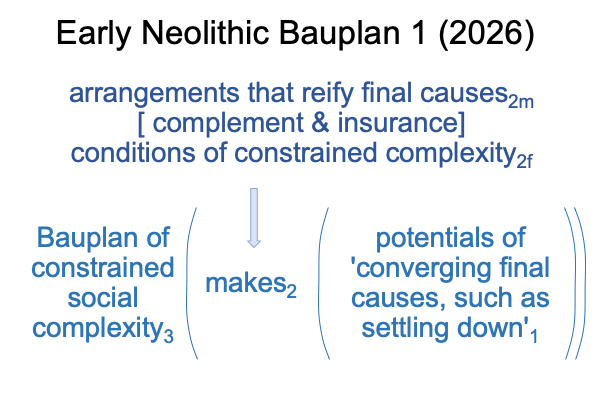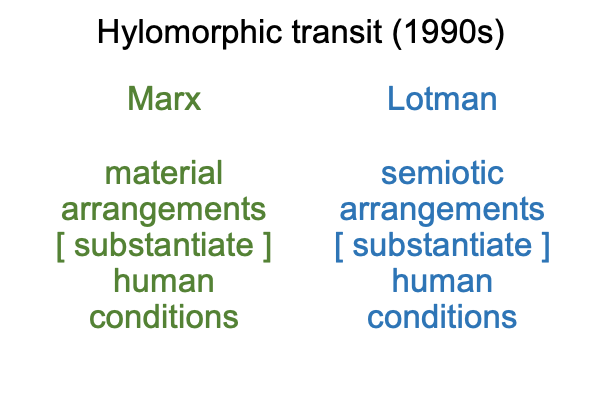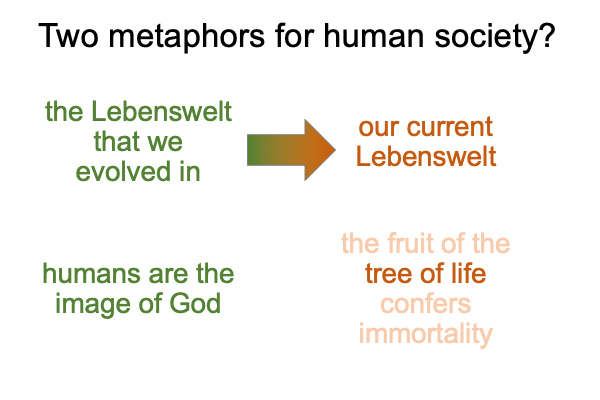Looking at Melinda A. Zeder’s Article (2025) “Unpacking the Neolithic” (Part 4 of 4)
0056 Okay, I will continue drinking my cocktail in the following exposition.
I regard the last two figures, along with the figures that appear in the article under examination.
0057 There is something in B that suggests two bauplans3. Early Neolithic Bauplan 1 marks the terminus of the Lebenswelt that we evolved in. Late Neolithic Bauplan 2 denotes the start of our current Lebenswelt.
0058 Bauplan 1 looks like this.

The early Neolithic bauplan3 does not permit untrammeled social and labor specializations. Rather, all social circles2m (family (5), friends (5), teams (15), bands (50), and community (150)) are optimized2f in the pursuit of the final cause of ‘settling down’1. It is the same way that different organs and organ systems are optimized for ‘settling down’ into an individual.
Details of optimization will be specific to each location (because efficient causes differ), yet produce something ‘general’, that manifests in excavation sites as varied as Catal Hoyuk and Tepe Gobekli. Domestication includes the local geography, plants and animals. Domestication may even include settlements more than a day’s walk away. Domestication may include the heavens.
0059 Once rendered in this manner, the slow, seemingly reversible, spiral into the neolithic thing2 gets depicted as thin dotted horizontal lines along the axes of arrangements versus time.
0060 The late Neolithic bauplan3 permits individual social and labor specializations. Something significant has changed. The key final cause of ‘settling down’ remains relevant. However, another key final cause cannot be ignored. The optimization of the early Neolithic somehow breaks down and the late Neolithic initiates a search for order1 that continues to this day.
0061 Here is a picture of what Bauplan 2 might look like.

0062 It is as if an individual, having been formed by a bauplan 1 gestation, gets born.
What a rude awakening.
0063 What about the timeline?
If I replace the increasing boldness of the horizontal dotted lines with a slowly rising bauplan 1 slope, and if I depict the most bold horizontal dotted lines as a bauplan 2 phase transition, then I get the following graph.

0064 What does this imply?
Obviously, bauplan 1 ends in a twist, that is, bauplan 2.
I noted this slogan at the start of my examination.
0065 Less obviously, the Neolithic revolution is not in the actuality of {material arrangements [substantiating] the neolithic condition}2.
“The Neolithic Revolution” involves a transition from the Lebenswelt that we evolved in to our current Lebenswelt.
0066 Fortunately, for the author, the American Marxist academic candle is about to exhaust itself, just as the Soviet Marxist illumination did decades ago.
Yes, the crisis begins.
0067 The impending change of cognitive grounds will be at least as great as the following transition from Karl Marx (1818-1883) to Juri Lotman (1922-1993). This transition goes sigmoidal in 1989.
0068 The following hylomorphic transition is derived in Razie Mah’s blog for December 2025, titled Looking at Igor Pilshchikov and Mikhail Trunin’s Article (2016) “The Tartu-Moscow School of Semiotics”.

0069 Marx’s actuality2 is supposed to arise from the potential of scientific models1, even though the actuality2 served as doctrine, rather than a mechanical or mathematical formulation. Remember, Marx’s actuality2 conforms to the structure of Peirce’s secondness. Secondness is the realm of actuality. How easy is it to confuse this actuality with the realness of a mechanical or mathematical model? Yet, they are not the same.
0070 Lotman’s actuality2 arises from the potential of the semiosphere1, the universe of sign-relations. Semiotic arrangements are not the same as material arrangements. They are not even close.
0071 So, what am I saying?
The author senses that ‘something’ is coming and she figures out that it must concern a bauplan.
After all, bauplan is a term that is familiar to evolutionary biologists.
0072 Happily, the semiotician, Razie Mah, has already explored human evolution from the point of view of Peirce’s categories. The human bauplan is an adaptation to the niche (or the potential) of triadic relations. Plus, human evolution comes with a twist.
Here is a list of works by Razie Mah that pertain to Bauplan 1 and Bauplan 2.

0073 Surely, this is a lot to unpack. But, that is precisely what Melinda Zeder’s article calls for.
My thanks to the author for publishing this thought piece.
Happy New Year.


